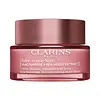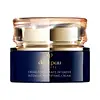What's inside
What's inside
 Key Ingredients
Key Ingredients

 Benefits
Benefits

 Concerns
Concerns

 Ingredients Side-by-side
Ingredients Side-by-side

Water
Skin ConditioningDicaprylyl Ether
EmollientCaprylic/Capric Triglyceride
MaskingBetaine
HumectantGlycerin
HumectantCetearyl Alcohol
EmollientNiacinamide
SmoothingDimethicone
EmollientAmmonium Acryloyldimethyltaurate/Vp Copolymer
Glyceryl Stearate
EmollientPEG-100 Stearate
Parfum
MaskingPropylene Glycol
HumectantCellulose
AbsorbentCetearyl Glucoside
EmulsifyingCaprylyl Glycol
EmollientHydroxyacetophenone
AntioxidantButylene Glycol
HumectantPolysilicone-11
Chlorphenesin
AntimicrobialTocopheryl Acetate
AntioxidantDisodium EDTA
Eryngium Maritimum Extract
TonicMarrubium Vulgare Extract
Skin ConditioningPhenethyl Alcohol
MaskingDecyl Glucoside
CleansingFurcellaria Lumbricalis Extract
Skin ConditioningArbutus Unedo Fruit Extract
AntioxidantTocopherol
AntioxidantLapsana Communis Flower/Leaf/Stem Extract
Skin ConditioningMaris Sal
Skin ConditioningAcetyl Tetrapeptide-2
Skin ConditioningDextran
Water, Dicaprylyl Ether, Caprylic/Capric Triglyceride, Betaine, Glycerin, Cetearyl Alcohol, Niacinamide, Dimethicone, Ammonium Acryloyldimethyltaurate/Vp Copolymer, Glyceryl Stearate, PEG-100 Stearate, Parfum, Propylene Glycol, Cellulose, Cetearyl Glucoside, Caprylyl Glycol, Hydroxyacetophenone, Butylene Glycol, Polysilicone-11, Chlorphenesin, Tocopheryl Acetate, Disodium EDTA, Eryngium Maritimum Extract, Marrubium Vulgare Extract, Phenethyl Alcohol, Decyl Glucoside, Furcellaria Lumbricalis Extract, Arbutus Unedo Fruit Extract, Tocopherol, Lapsana Communis Flower/Leaf/Stem Extract, Maris Sal, Acetyl Tetrapeptide-2, Dextran
Water
Skin ConditioningAlcohol Denat.
AntimicrobialGlycerin
HumectantDipropylene Glycol
HumectantHydrogenated Polydecene
EmollientCetyl Ethylhexanoate
EmollientDimethicone
EmollientPEG/PPG-14/7 Dimethyl Ether
Skin ConditioningPEG-60 Glyceryl Isostearate
Trehalose
HumectantPotassium Methoxysalicylate
BleachingPEG-5 Glyceryl Stearate
EmulsifyingPhenoxyethanol
PreservativePetrolatum
EmollientStearic Acid
CleansingButylene Glycol
HumectantBehenyl Alcohol
EmollientIsostearic Acid
CleansingBehenic Acid
CleansingCarbomer
Emulsion StabilisingTheanine
EmollientPotassium Hydroxide
BufferingBatyl Alcohol
EmollientPEG/PPG-17/4 Dimethyl Ether
Skin ConditioningTocopheryl Acetate
AntioxidantXanthan Gum
EmulsifyingPhytosteryl Macadamiate
Skin ConditioningParfum
MaskingAlcohol
AntimicrobialEctoin
Skin ConditioningSodium Metaphosphate
BufferingDisodium EDTA
Dipotassium Glycyrrhizate
HumectantSodium Metabisulfite
AntioxidantAlpha-Isomethyl Ionone
PerfumingCitronellol
PerfumingLinalool
PerfumingAngelica Acutiloba Root Extract
Skin ConditioningOlea Europaea Leaf Extract
PerfumingGeraniol
PerfumingPaeonia Albiflora Root Extract
Skin ConditioningPanax Ginseng Root Extract
EmollientBenzyl Benzoate
AntimicrobialHydrolyzed Silk
HumectantSerine
MaskingGlycine
BufferingRubus Suavissimus Leaf Extract
Skin ConditioningOnonis Spinosa Root Extract
AntiseborrhoeicCI 77491
Cosmetic ColorantCI 77492
Cosmetic ColorantCinnamomum Cassia Bark Extract
MaskingLavandula Angustifolia Oil
MaskingTocopherol
AntioxidantRosa Canina Fruit Extract
AstringentHibiscus Esculentus Fruit Extract
Skin ConditioningFagus Sylvatica Bud Extract
TonicSodium Acetylated Hyaluronate
HumectantPerilla Ocymoides Leaf Extract
TonicBenzoic Acid
MaskingUncaria Gambir Extract
AstringentRosa Roxburghii Fruit Extract
TonicHydrolyzed Conchiolin Protein
Skin ConditioningBupleurum Falcatum Root Extract
Skin ConditioningWater, Alcohol Denat., Glycerin, Dipropylene Glycol, Hydrogenated Polydecene, Cetyl Ethylhexanoate, Dimethicone, PEG/PPG-14/7 Dimethyl Ether, PEG-60 Glyceryl Isostearate, Trehalose, Potassium Methoxysalicylate, PEG-5 Glyceryl Stearate, Phenoxyethanol, Petrolatum, Stearic Acid, Butylene Glycol, Behenyl Alcohol, Isostearic Acid, Behenic Acid, Carbomer, Theanine, Potassium Hydroxide, Batyl Alcohol, PEG/PPG-17/4 Dimethyl Ether, Tocopheryl Acetate, Xanthan Gum, Phytosteryl Macadamiate, Parfum, Alcohol, Ectoin, Sodium Metaphosphate, Disodium EDTA, Dipotassium Glycyrrhizate, Sodium Metabisulfite, Alpha-Isomethyl Ionone, Citronellol, Linalool, Angelica Acutiloba Root Extract, Olea Europaea Leaf Extract, Geraniol, Paeonia Albiflora Root Extract, Panax Ginseng Root Extract, Benzyl Benzoate, Hydrolyzed Silk, Serine, Glycine, Rubus Suavissimus Leaf Extract, Ononis Spinosa Root Extract, CI 77491, CI 77492, Cinnamomum Cassia Bark Extract, Lavandula Angustifolia Oil, Tocopherol, Rosa Canina Fruit Extract, Hibiscus Esculentus Fruit Extract, Fagus Sylvatica Bud Extract, Sodium Acetylated Hyaluronate, Perilla Ocymoides Leaf Extract, Benzoic Acid, Uncaria Gambir Extract, Rosa Roxburghii Fruit Extract, Hydrolyzed Conchiolin Protein, Bupleurum Falcatum Root Extract
Ingredients Explained
These ingredients are found in both products.
Ingredients higher up in an ingredient list are typically present in a larger amount.
Butylene Glycol (or BG) is used within cosmetic products for a few different reasons:
Overall, Butylene Glycol is a safe and well-rounded ingredient that works well with other ingredients.
Though this ingredient works well with most skin types, some people with sensitive skin may experience a reaction such as allergic rashes, closed comedones, or itchiness.
Learn more about Butylene GlycolDimethicone is a type of synthetic silicone created from natural materials such as quartz.
What it does:
Dimethicone comes in different viscosities:
Depending on the viscosity, dimethicone has different properties.
Ingredients lists don't always show which type is used, so we recommend reaching out to the brand if you have questions about the viscosity.
This ingredient is unlikely to cause irritation because it does not get absorbed into skin. However, people with silicone allergies should be careful about using this ingredient.
Note: Dimethicone may contribute to pilling. This is because it is not oil or water soluble, so pilling may occur when layered with products. When mixed with heavy oils in a formula, the outcome is also quite greasy.
Learn more about DimethiconeDisodium EDTA plays a role in making products more stable by aiding other preservatives.
It is a chelating agent, meaning it neutralizes metal ions that may be found in a product.
Disodium EDTA is a salt of edetic acid and is found to be safe in cosmetic ingredients.
Learn more about Disodium EDTAGlycerin is already naturally found in your skin. It helps moisturize and protect your skin.
A study from 2016 found glycerin to be more effective as a humectant than AHAs and hyaluronic acid.
As a humectant, it helps the skin stay hydrated by pulling moisture to your skin. The low molecular weight of glycerin allows it to pull moisture into the deeper layers of your skin.
Hydrated skin improves your skin barrier; Your skin barrier helps protect against irritants and bacteria.
Glycerin has also been found to have antimicrobial and antiviral properties. Due to these properties, glycerin is often used in wound and burn treatments.
In cosmetics, glycerin is usually derived from plants such as soybean or palm. However, it can also be sourced from animals, such as tallow or animal fat.
This ingredient is organic, colorless, odorless, and non-toxic.
Glycerin is the name for this ingredient in American English. British English uses Glycerol/Glycerine.
Learn more about GlycerinParfum is a catch-all term for an ingredient or more that is used to give a scent to products.
Also called "fragrance", this ingredient can be a blend of hundreds of chemicals or plant oils. This means every product with "fragrance" or "parfum" in the ingredients list is a different mixture.
For instance, Habanolide is a proprietary trade name for a specific aroma chemical. When used as a fragrance ingredient in cosmetics, most aroma chemicals fall under the broad labeling category of “FRAGRANCE” or “PARFUM” according to EU and US regulations.
The term 'parfum' or 'fragrance' is not regulated in many countries. In many cases, it is up to the brand to define this term.
For instance, many brands choose to label themselves as "fragrance-free" because they are not using synthetic fragrances. However, their products may still contain ingredients such as essential oils that are considered a fragrance by INCI standards.
One example is Calendula flower extract. Calendula is an essential oil that still imparts a scent or 'fragrance'.
Depending on the blend, the ingredients in the mixture can cause allergies and sensitivities on the skin. Some ingredients that are known EU allergens include linalool and citronellol.
Parfum can also be used to mask or cover an unpleasant scent.
The bottom line is: not all fragrances/parfum/ingredients are created equally. If you are worried about fragrances, we recommend taking a closer look at an ingredient. And of course, we always recommend speaking with a professional.
Learn more about ParfumTocopherol (also known as Vitamin E) is a common antioxidant used to help protect the skin from free-radicals and strengthen the skin barrier. It's also fat soluble - this means our skin is great at absorbing it.
Vitamin E also helps keep your natural skin lipids healthy. Your lipid skin barrier naturally consists of lipids, ceramides, and fatty acids. Vitamin E offers extra protection for your skin’s lipid barrier, keeping your skin healthy and nourished.
Another benefit is a bit of UV protection. Vitamin E helps reduce the damage caused by UVB rays. (It should not replace your sunscreen). Combining it with Vitamin C can decrease sunburned cells and hyperpigmentation after UV exposure.
You might have noticed Vitamin E + C often paired together. This is because it is great at stabilizing Vitamin C. Using the two together helps increase the effectiveness of both ingredients.
There are often claims that Vitamin E can reduce/prevent scarring, but these claims haven't been confirmed by scientific research.
Learn more about TocopherolTocopheryl Acetate is AKA Vitamin E. It is an antioxidant and protects your skin from free radicals. Free radicals damage the skin by breaking down collagen.
One study found using Tocopheryl Acetate with Vitamin C decreased the number of sunburned cells.
Tocopheryl Acetate is commonly found in both skincare and dietary supplements.
Learn more about Tocopheryl AcetateWater. It's the most common cosmetic ingredient of all. You'll usually see it at the top of ingredient lists, meaning that it makes up the largest part of the product.
So why is it so popular? Water most often acts as a solvent - this means that it helps dissolve other ingredients into the formulation.
You'll also recognize water as that liquid we all need to stay alive. If you see this, drink a glass of water. Stay hydrated!
Learn more about Water